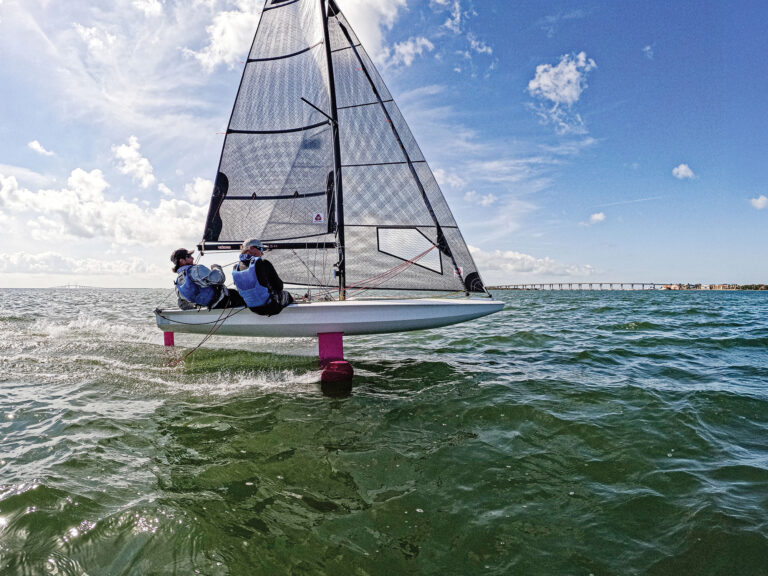
marks and obstructions 368
On Jan. 1, 2009, the revised edition of The Racing Rules of Sailing will apply. This time around only one part of the rulebook has undergone major surgery: Section C of the Part 2 rules, which contains the rules that apply at marks and obstructions. The changes in the rest of the rulebook are relatively insignificant.
In this article I will present a brief outline of the process ISAF followed to generate the new rules, the goals that ISAF set, and then a tour of the major changes. After I’ve explained the main points, I will go into more detail on individual rules, showing you exactly how they differ from the 2005-2008 rules and giving you the reasons for the changes. I will begin this process this month and then complete it in future issues. Before you read further, however, I suggest you view the new version of the rules, available online at www.sailing.org/rrs.
While competitors generally liked the “game” that the old Section C rules produced, many, including the last two ISAF presidents, thought they were unnecessarily complex and ambiguous and called for simplification. In 2005 and 2006, US SAILING’s Racing Rules Committee and the Royal Yachting Association Racing Rules Committee developed several drafts of possible revisions of Section C; two of the U.S. drafts were tested on the water by various fleets during the summer of 2006. Using the U.S. and RYA drafts and feedback from competitors and race officials as initial input, a special ISAF working party drafted the new Section C rules. Its members were Chris Atkins and Richard Thompson, from England, and Ben Altman, Rob Overton, and me, from the United States.
ISAF set five principal goals for the new Section C rules: The new rules should (1) reflect the way sailors sail today at marks and obstructions; (2) make it easier to figure out which rules apply in any situation; (3) simplify and clarify by eliminating ambiguities; (4) discourage contact by encouraging orderly behavior and discouraging last minute claims for room; and (5) not “switch off” the basic right-of-way rules in Section A or the Section B rules.
Three rules, not two
The first big change to note is that there are now three, instead of two, rules in Section C-Rule 18, Mark-Room; Rule 19, Room to Pass an Obstruction; and Rule 20, Room to Tack at an Obstruction. Old Rule 18 covered passing both marks and obstructions. New Rule 18 covers almost all marks, while new Rule 19 applies to most obstructions. However, this means that it now takes a little more thought to figure out which Section C rule applies in a given situation.
Here’s why we established a new Rule 19 for passing obstructions: Under the old rules, the rule that applied when passing an obstruction, Rule 18, was the same as the one that applied at marks. However, few competitors sailed as if the rules were the same at obstructions as they were at marks. They almost invariably did not consider the two-length zone around obstructions. Moreover, in the common situation in which two overlapped starboard-tack boats were approaching from clear astern a line of starboard-tack boats waiting for the starting signal, it was impracticable to consider the zone around each of the boats in that line as old Rule 18 required. New Rule 19, which does not use the zone concept, is essentially the simplified rule that most sailors sail by today when passing an obstruction. It more accurately reflects the “game” that is played at obstructions today in fleet racing. In addition, at an obstruction, new Rule 19 is far simpler than old Rule 18.
With apologies to Garrison Keillor, I’ve chosen to illustrate situations in which each of the new Section C rules apply using one large diagram showing a snapshot of a Wednesday evening race for several classes held by the Lake Wobegon Sailing Club on Lake Wobegon. At the LWSC all the women are strong, all the men are good looking, and all the boats have above average boatspeed. Of course, most of the competitors are Scandinavians.
The starting line was set just off the clubhouse and was between flags on two committee boats. The course was a beat to Mark 1, a swim float, then a reach to Mark 2, String Bean Island, a run to Mark 3, a reach to Mark 4 and a beat to the finishing line, which was the same as the starting line. All four rounding marks were to be left to port. At the moment shown in the diagram, the last class, the Optis, was about to start, and the faster boats that started earlier were well on their way around the course. The diagram shows several common situations. Let’s figure out which new rule applies to each.
Three of the marks, the two committee boats on the ends of the starting line and Mark 1, an anchored swimming float, are both marks and obstructions, but they are not so large that they are continuing obstructions. Mark 2, String Bean Island, is both a mark and a continuing obstruction. Marks 3 and 4, small inflated buoys, are marks but are not large enough to be obstructions. Sven, beating on starboard tack, is an obstruction to both Leif and Lars, who are beating on port tack. A trolling fishing boat moving just slightly slower than Beret and Axel, and in the same direction, is an obstruction to each of them. However, even though it could take them a minute or so to pass it, it is not a continuing obstruction because a new sentence has been added to the definition Obstruction stating, “A vessel under way is never a continuing obstruction.” Whether or not such an obstruction was a continuing obstruction under the old rules was often debated and impossible to determine; now we know.
You can determine which rule applies in each of these situations by reading the preamble to Section C and the first part of each of the three rules-i.e., Rules 18.1, 19.1, and 20.1. Because the two race committee boats at the ends of the starting line are starting marks surrounded by navigable water, none of the Section C rules apply to those two marks or their anchor lines from the time boats are approaching them to start until they have passed them (see Section C preamble). Rule 18 applies at Mark 1 between Selma and Soren and at Mark 3 between Stig and Peder (see Rule 18.1). Because the swim float is a mark that Selma and Soren must leave to port, Rule 18 applies at it between them even though the swim float is an obstruction as well as a mark (see Rule 19.1). Because Per is on port tack and Soren and Selma are on starboard, Rule 18 does not apply either between Per and Soren or between Per and Selma (see Rules 18.1(a) and (b)). However, when Per changes tacks by turning past head to wind, Rule 18.3 will begin to apply between him and Soren and between him and Selma.
Rule 19 applies at Mark 2 between Inga and Olaf because Mark 2 is a continuing obstruction (see either Rule 18.1(d) or Rule 19.1).
Sven is an obstruction to both Lars and Leif. Lars has right of way over Leif under Rule 11 and, therefore, can choose whether to duck behind Sven or to tack to avoid him (see Rule 19.2(a)). If Lars chooses to bear away, then Rule 19.2(b) applies between him and Leif. If Lars elects to tack to avoid Sven, then he must hail Leif for room to tack. In that case Rule 20 applies and Rule 19 does not (see Section C preamble).
Axel has right of way over Beret under either Rule 12 or Rule 11 and, therefore, can choose to pass the trolling fishing boat on either side (see Rule 19.2(a)). Rule 19.2(b), but not Rule 19.2(c), applies as they pass it.
The Zone redefined
The second big change in new Section C is in new Rule 18 and the definition Zone. The new rule, like its predecessor, applies between two boats when they are required to leave a mark on the same side. The old rule began to apply when the boats were “about to round or pass” the mark. When this occurred was not defined in the rules, and the two ISAF cases (Cases 84 and 94) that tried to clarify when a boat was about to round or pass did not do a good job. Indeed, Case 84 said, “The phrase about to round or pass has never been defined precisely, nor can it be.” This ambiguity has led to dangerous and expensive collisions, especially in fresh winds when two sportboats with asymmetric spinnakers set were approaching a starboard-rounding leeward mark sailing fast on opposite tacks. Moreover, under old Rules 18.2(b) and (c), the time at which the obligations on the boats were “locked in”-when the first of them reached the two-length zone-was different from the time that the rule began to apply. New Rule 18 is far simpler and clearer. The moment at which new Rule 18 begins to apply is the same as the moment at which the obligations are “locked in.” That moment is when the first of them is in the zone.
The definition Zone has been changed in three important ways. (1) Most important, the zone’s size has been increased from two lengths to three lengths. (2) The new definition specifies what it means to be “in the zone”-a boat is in the zone when any part of her hull is in the zone. (3) The new term zone is only defined for marks, whereas under the old rules there was a two-length zone for both marks and obstructions. In 2006 sailors in several fleets tested this larger, three-length zone and reported that mark roundings were more orderly, less contentious and resulted in fewer collisions because there was more time to sort out who was going to give room to whom.
New definition mark-room
The third big change is the introduction of a new definition, Mark-Room (see its text in nearby box). This new definition fixes three problems that the old definition for room at a mark had. (1) The old definition was located in a preamble to Rule 18 and not in the Definitions section of the rulebook. As a result, it was often overlooked. (2) It only covered room for an inside boat to round or pass between an outside boat and the mark. However, old Rule 18.2 required an outside boat to give room from the time that Rule 18 began to apply until the inside boat needed room to pass between her and the mark. During this time interval the boats sailed for at least two hull lengths before reaching the mark, and it was not at all clear what the obligation on the outside boat was during this period. (3) The old definition only covered overlapped boats, but old Rule 18.2(b) required a boat to give room even if “the overlap is broken.”
The new definition has none of these problems. Henceforth, if an inside boat is entitled to mark-room, then before she arrives at the mark she is entitled to “room to sail to the mark,” i.e., the space she needs in the existing conditions to sail promptly to the mark in a seamanlike way. After she arrives at the mark, she is entitled to room to sail her proper course as she rounds or passes it. One final note: The only rule in which the term mark-room is used is Rule 18.
The last of the big changes is that none of the new Section C rules will ever “take precedence” over any of the basic Right-of-Way Rules in Section A or the General Limitations in Section B. Therefore, the new Section C rules do not “switch off” any rule in Section A or B. (There is one exception, that will rarely come into play, in new Rule 19.2(c).) This change was accomplished by deleting the preamble to old Section C.
New Rules 18.5 and 20.2 deal with the situations to which the old preamble and old (now deleted) Rule 18.2(d) applied. In the Rules column in the next issue of Sailing World I will discuss these two new rules and give examples of situations in which they apply.
E-mail for Dick Rose may be sent to [email protected].









